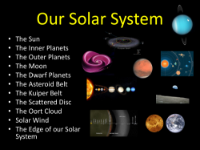Life Beyond Neptune: The Kuiper Belt & Scattered Disc
Video
Science
+1
Science
7th Grade - 9th Grade
Premium

S
SciShow Space
Science Resource Description
The solar system is enormous, and includes the Kuiper Belt and the Scattered Disc, both of which turn out to be really weird in some pretty awesome ways.
We want to learn more about you and your opinions! If you have time, please take a moment to fill out this survey: https://www.surveymonkey.com/r/SciShowSurvey2017
Thank you!
Hosted by: Reid Reimers
----------
Support SciShow by becoming a patron on Patreon: https://www.patreon.com/scishow
----------
Dooblydoo thanks go to the following Patreon supporters:
Kelly Landrum Jones, Sam Lutfi, Kevin Knupp, Nicholas Smith, Inerri, D.A. Noe, alexander wadsworth, سلطان الخليفي, Piya Shedden, KatieMarie Magnone, Scott Satovsky Jr, Bella Nash, Charles Southerland, Bader AlGhamdi, James Harshaw, Patrick Merrithew, Patrick D. Ashmore, Candy, Tim Curwick, charles george, Saul, Mark Terrio-Cameron, Viraansh Bhanushali, Kevin Bealer, Philippe von Bergen, Chris Peters, Justin Lentz
----------
Like SciShow? Want to help support us, and also get things to put on your walls, cover your torso and hold your liquids? Check out our awesome products over at DFTBA Records: http://dftba.com/scishow
----------
Looking for SciShow elsewhere on the internet?
Facebook: http://www.facebook.com/scishow
Twitter: http://www.twitter.com/scishow
Tumblr: http://scishow.tumblr.com
Instagram: http://instagram.com/thescishow
----------
Sources:
http://pluto.jhuapl.edu/Participate/learn/What-We-Know.php?link=The-Kuiper-Belt
https://solarsystem.nasa.gov/planets/kbos/indepth
http://www.nature.com/nature/journal/v362/n6422/abs/362730a0.html?foxtrotcallback=true
https://imagine.gsfc.nasa.gov/features/cosmic/solar_system_info.html
https://www.nasa.gov/feature/new-horizons-reveals-pluto-s-atmospheric-pressure-has-sharply-decreased
http://pluto.jhuapl.edu/News-Center/PI-Perspectives.php?page=piPerspective_08_08_2017
https://www.space.com/34066-pluto-moon-charon-red-spot-source.html
https://www.nature.com/nature/journal/v522/n7554/full/nature14469.html
https://solarsystem.nasa.gov/planets/oort/indepth
http://iopscience.iop.org/article/10.3847/2041-8205/819/2/L38/pdf
http://www.astronomy.ohio-state.edu/~pogge/Ast161/Unit4/dance.html
Images:
https://en.wikipedia.org/wiki/File:PIA17046_-_Voyager_1_Goes_Interstellar.jpg
https://en.wikipedia.org/wiki/File:Astronomical_unit.png
https://en.wikipedia.org/wiki/File:Lhborbits.png
https://en.wikipedia.org/wiki/File:Kuiper_belt_-_Oort_cloud-en.svg
https://en.wikipedia.org/wiki/File:Artist%27s_impression_dwarf_planet_Eris.jpg
https://en.wikipedia.org/wiki/File:Eris_Orbit.svg
https://en.wikipedia.org/wiki/File:EightTNOs.png
https://en.wikipedia.org/wiki/File:Pluto-FlyoverAnimation-20150918.webm
https://en.wikipedia.org/wiki/File:Haumea_rotation_with_ring.gif
https://en.wikipedia.org/wiki/File:Neptune_Full.jpg
https://en.wikipedia.org/wiki/File:Pluto-01_Stern_03_Pluto_Color_TXT.jpg
https://en.wikipedia.org/wiki/File:Pluto-BlueSkyFinal_PIA21590.jpg
https://en.wikipedia.org/wiki/File:14-281-KuiperBeltObject-ArtistsConcept-20141015.jpg
https://exoplanets.nasa.gov/news/1400/interstellar-crossing-the-cosmic-void/
Explore other content in this scheme
Part of a lesson by Teach with Fergy
Other resources in this lesson

NASA | SDO: Year 5
Resource
Science
+1
11th Grade - 12th Grade

How Could We Create A Second Earth?
Resource
Science
+1
11th Grade - 12th Grade

Venus 101 | National Geographic
Resource
Science
+1
7th Grade - 9th Grade

Mars: when will humans get there?
Resource
Science
+1
7th Grade - 9th Grade

What Would Happen If Humans Tried To Land On Jupiter
Resource
Science
+1
7th Grade - 9th Grade

Saturn Is Officially Losing Its Rings
Resource
Science
+1
7th Grade - 9th Grade

Uranus 101 | National Geographic
Resource
Science
+1
7th Grade - 9th Grade

The Asteroid Belt: Not What You Think!
Resource
Science
+1
7th Grade - 9th Grade

Where does the solar system end? The Oort Cloud.
Resource
Science
+1
7th Grade - 9th Grade

Solar Wind: A Silent Threat | Strip the Cosmos
Resource
Science
+1
7th Grade - 9th Grade

The Solar System - Exit Ticket
Resource
Science
+1
7th Grade - 9th Grade

Our Solar System - The Sun to The Oort Cloud Student Presentation
Resource
Science
+1
7th Grade - 9th Grade

Our Solar System - The Sun to The Oort Cloud Teaching Presentation
Resource
Science
+1
7th Grade - 9th Grade

Our Solar System - The Sun to The Oort Cloud Student Lesson Outline
Resource
Science
+1
7th Grade - 9th Grade
